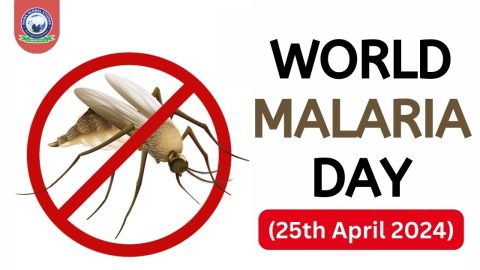World Malaria Day is observed every year on 25th April to raise awareness about malaria, a deadly and infectious disease. The day aims to spread information about preventive measures, promote community involvement in eradicating the disease, and strengthen global efforts in the fight against malaria. It also serves as an opportunity to honor those who are playing a vital role in the mission against malaria – healthcare workers, researchers, and social workers.
This day was officially recognized by the World Health Organization (WHO) in 2007, although its roots go back to 2001, when Africa Malaria Day was first observed. Malaria is prevalent in regions like Africa, South Asia, and Latin America, and continues to impact millions of lives globally.
History of World Malaria Day
In 2001, African nations began observing Africa Malaria Day, primarily to step up their efforts in eliminating malaria from the continent.
Later, in 2007, the WHO recognised it globally and declared it World Malaria Day to encourage united global efforts in fighting the disease.
- Objectives:
- Spread global awareness about malaria
- Promote prevention and treatment efforts
- Strengthen cooperation among governments, organizations, and citizens
What is Malaria?
Malaria is a life-threatening infectious disease caused by a parasite called Plasmodium. This parasite enters the human body through the bite of a female Anopheles mosquito. Inside the body, it infects red blood cells and gradually deteriorates the health of the person.
- Common Symptoms of Malaria:
- High fever and chills
- Excessive sweating
- Headache and body aches
- Nausea and vomiting
- Fatigue and weakness
- In severe cases, it can lead to organ failure and even death
With timely treatment and proper care, malaria is a curable disease.
Major Mosquito Species and Associated Diseases
There are more than 3,000 species of mosquitoes globally, but only a few of them infect humans. In India, there are three major types of mosquitoes responsible for spreading various diseases:
- Female Anopheles Mosquito
- Disease: Malaria
- Active Time: Night
- Breeding Grounds: Clean or dirty, stagnant water
- Characteristic: The only mosquito that transmits malaria
- Aedes Mosquito
- Diseases: Dengue, Chikungunya, Zika virus, Yellow fever
- Active Time: Daytime
- Breeding Grounds: Clean stagnant water (tyres, flowerpots, containers, etc.)
- Characteristic: Known for transmitting rapidly spreading viral diseases
- Culex Mosquito
- Diseases: Japanese Encephalitis, Filariasis (Elephantiasis), West Nile Virus
- Active Time: Evening and night
- Breeding Grounds: Dirty water, drains, sewage
- Characteristic: Common in urban areas
Global and Indian Scenario
- Global Scenario:
- Every year, approximately 240 million people are affected by malaria
- Over 600,000 deaths are reported annually
- Most affected regions: Africa (over 70% of cases), South Asia, South America
- Scenario in India:
- Malaria spreads during the monsoon and rainy seasons in various Indian states
- Most affected states: Odisha, Jharkhand, Chhattisgarh, Madhya Pradesh, Northeastern states
- Major initiatives against malaria in India:
- NVBDCP (National Vector Borne Disease Control Programme)
- NFME (National Framework for Malaria Elimination) 2016–2030
Preventive Measures Against Malaria
- Use mosquito nets regularly
- Avoid water stagnation – clean coolers, pots, tyres, etc.
- Wear clothes that cover the body
- Apply mosquito repellent creams or sprays
- Cooperate with health departments during fogging or spraying
- Consult a doctor immediately if you have fever or symptoms
Key Initiatives by the Government of India
- Target to eliminate malaria under NFME 2016–2030
- Monitoring by field workers and ASHA workers in rural and urban areas
- Quick identification through Rapid Diagnostic Test (RDT) kits
- Awareness campaigns at the school and village level
- Regular health camps and free treatment programs by the government
Theme of World Malaria Day 2025
The theme for World Malaria Day 2025 is: “End Malaria with Us: Reinvest, Reimagine, Reignite”
This year’s theme reminds us that defeating malaria requires more than just medicines or technology. It demands fresh ideas, collective efforts, and renewed commitment. The theme highlights three key pillars:
- Reinvest: Refocus and allocate resources toward malaria elimination
- Reimagine: Adopt new strategies, digital tools, and innovations
- Reignite: Revitalise public engagement and awareness campaigns
Year-wise Themes of World Malaria Day
| Year | Theme |
| 2024 | Accelerating the fight against malaria for a more equitable world |
| 2023 | Time to deliver zero malaria: invest, innovate, implement |
| 2022 | Harness innovation to reduce the malaria disease burden and save lives |
| 2021 | Reaching the zero malaria target |
| 2020 | Zero malaria starts with me |
| 2019 | Zero malaria starts with me |
| 2018 | Ready to beat malaria |
Conclusion
World Malaria Day serves as a reminder that if we all remain aware, maintain hygiene, get timely treatment, and support government efforts, a deadly disease like malaria can be eradicated at its root.
The dream of a malaria-free India by 2030 can only be achieved if each of us understands our personal responsibility and becomes an active part of this mission.




